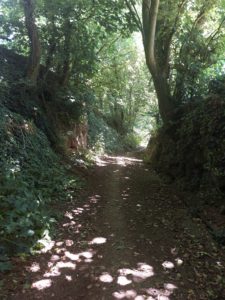 How long is Christmas? Until Candlemas? It’s should be long enough to deal with Blue Monday. In fact, for me Blue Monday should be in February. Why? Leftover Christmas liqueurs! There are still leftover Christmas liqueurs in the cabinet. Sure, it’s a dribble of Cointreau and some sort of nut cream thing but it’s still the holidays in some vestigial sense until that goes. Another way to beat the blues is to be not blue except in terms of your toes and your nose. Get out and see that blue sky. Jeff took a great walk to a brewery near Prague this week and shared some of the countryside, one image of which is right there:
How long is Christmas? Until Candlemas? It’s should be long enough to deal with Blue Monday. In fact, for me Blue Monday should be in February. Why? Leftover Christmas liqueurs! There are still leftover Christmas liqueurs in the cabinet. Sure, it’s a dribble of Cointreau and some sort of nut cream thing but it’s still the holidays in some vestigial sense until that goes. Another way to beat the blues is to be not blue except in terms of your toes and your nose. Get out and see that blue sky. Jeff took a great walk to a brewery near Prague this week and shared some of the countryside, one image of which is right there:
Prague tip: a hike from Prague castle to the satellite town of Únětice is only about 13km, really varied and ends at my favourite Czech brewery. Regular buses go back to the city and you could even summon up an Uber, so you’re not stranded at the end...
Speaking of wandering around Prague, remember when people like Evan wrote short stories around beer? Remember Beer Haiku Daily? Well, Beergeek is writing like its 2012 and getting creative, like this:*
If beer replaced water, swimming would be a very different experience. For one thing, the buoyancy of beer might be different from that of water, so it could be more or less difficult to swim depending on the specific gravity of the beer. Additionally, beer is not as clear as water, so visibility while swimming might be reduced.
Speaking of out and about, Paste mag has published an interesting article about the drinking laws of Japan:
… the idea of “public consumption” in Japan goes even further than you’re probably imagining. Drinking in public transportation, for example, is also legal—booze is sold on the famed shinkansen system of high-speed rail, and it’s not illegal to swig from a hip flask on the train, or even a public bus. Perhaps most astoundingly, though, drinking on modes of private transportation such as cars is also legal for everyone but the driver. That’s right: You can be cruising down the highway with an open bottle of whiskey being passed back and forth between all the passengers, and that is legal under Japanese law.
Much to the contrary, Old Mudgie has shared thoughts about the loss of the love of and/or need for alcohol which he has witnessed over recent decades:
As something becomes less fashionable, people are more likely to prefer to do it in private than in public, which is bad news for the pub trade. According to the statistics produced by the British Beer & Pub Association, in the twenty years from 1998 to 2018 (which is as far as they go), total beer consumption fell by 22.8%, but on-trade consumption almost exactly halved. The trail of pubs now demolished or converted to alternative use is all too obvious. Some will argue that the Anteater Tap is still doing great business, while ignoring the fact that the Sir Garnet Wolseley across the road, which was ten times the size, has been replaced by flats. Even within a declining market, it is still possible to be successful, but that doesn’t make the wider narrative any less true.
Note: Oz hops ave.
Katie Mather has made the case for on-trade non-consuption of at least alcohol in here new piece for Pellicle on the pleasures of a lime and lemonade pub crawl:
When we decided to go on a lime and lemonade crawl, the idea started off as a plan to meet for food. Oversaturated by alcohol and the coming winter, we decided to make Mondays a strict no-alcohol day—the most obvious switch for a bar setting is one with food instead of drinks. But neither of us wanted food. We wanted the comfort of a pub, the atmosphere of a communal sitting room. We didn’t want to be wowed by flavours or waited on. We just wanted somewhere to belong. It’s easy to forget that you’re just as welcome in a pub as a non-drinker. Somehow it feels awkward; unusual. But, if you want to sit in a cosy corner and play cards, you go right ahead.
Note: infographics suck… suck. And is the use of isinglass really all that surprising? An odd criticism. I am still thinking of what it means to be critical in a closed or sorta closed circle like good beer and saw this interesting similar discussion of the issues which bear upon criticism of Indigenous arts written by Drew Hayden Taylor:
…while we don’t know every single Indigenous person in the country, we may know someone who knows someone who knows someone. They aren’t an anonymous, blank population. Knowing this can be difficult. As Glen Sumi, theatre critic at large, told me, “there’s also the possibility of being too close to the community you’re writing about — especially if you’ve worked with or are going to be working with some of the artists you’ll be reviewing.” True. I remember reading a quote from some famous novelist who said something to the effect of “I never felt freer as a writer than when my parents died.” Now picture that sense with a whole nation watching you. It can be somewhat problematic.
I would add one key distinction is that there is no community with good beer in the same sense even if there may be communities or at least circles. There is perhaps a sense of this in Eoghan‘s thoughts this week as well as something else:
…beer reviewing is subjective, and there are noses out there better able – thanks to training, genetics, or both – to catch what I missed. And that, beyond the intellectual vanity and the sensory chaos, is why I think I dislike decoding beers: I am uncomfortable with this ambiguity. I trust my eyes, dodgy as they are, and the neural pathways they follow. I don’t trust the messages coming from my olfactory system and the detours they take into memory and recall. Despite all this, there is a reason I became a beer writer and not an art critic (well, there are many). Because good and all as Velázquez’s royal portrait or Picasso’s colourful interpretation might be, on a terrace on a sunny day in Brussels, a 17th century oil on canvas just doesn’t hit the same way as a cold glass of Zinnebir.
At least it’s a beer made in Belgium and not the disassembly of a long dumbed down clone of something Belgian. Telling that the Fat Tire chat has very little to do with the beer, just the sideshow of the brand being scotch taped on a can with something other than Fat Tire in it. Best comment so far?
Alright. Can we all agree that (1) nobody’s had a Fat Tire in years; and (2) nobody’s allowed to talk about New Fat Tire anymore unless it’s about what’s in the fucking can and you include a poorly taken picture of it in a glass. It’s what we do.
There. That’s quite a bit. Well, a middling sort of week. And now on to the index of others. Really, indices. Again I ask… what song should play if this were a movie and you were there scrolling though the slowly building upon a randomized list of beer writing resources on Mastodon** followed by the podcasts ‘n’ stuff? This? Yes, that’s it – an exploration of exploration… over 50 years ago… yikes…***
Boak & Bailey | The B² experience
David Jesudason | “Desi Pubs” (2023) author
Ron Pattinson | The RonAlongAThon Himself
Al Reece AKA Velky Al | Fuggled
Jennifer Jordan | US hops historian
Alan McLeod | A Good Beer Blog (… me…)
Andreas Krennmair | Vienna beer and lager historian
Beer Ladies Podcast | Lisa Grimm and colleagues
Jay Brooks | Brookston Beer Bulletin
Joe Stange | Belgian beer expert, beer magazine editor
Cider Bar | Barry makes Kertelreiter cider
Laura Hadland | CAMRA historian and beer writer
Brian Alberts | US beer historian
Jon Abernathy | The Beer Site
Maureen Ogle | US Beer Historian
Lars Garshol | Norwegian Beer Historian and Kveik Hunter
James Beeson” | Beeson on Beer
Carla Jean | MAINER!!!
Thandi Guilherme | Beer Ladies Podcast Co-host
Lisa Grimm | Beer Ladies Podcast Co-host
Rob Talksbeer | Podcaster and Youtuber
Anthony Gladman | UK Drinks Writer
Jeff Alworth | Manna Of Beervana
Northwest Beer Guide | Fairly self explanatory… but not NW Latvia…
Evan Rail | Prague based GBH editor, freelance writer, NYT etc.
Todd Alström | 50% of the Alströms
Go have a look. And also check for more as the year picks up from Boak and Bailey every Saturday and Stan back at his spot on Mondays. It’s no longer the holidays. So, look around and check to see if there is the highly recommended Beer Ladies Podcast. The OCBG Podcast is on a very quiet schedule these days – but it there again! See also sometimes, on a Friday, posts at The Fizz as well (Ed.: we are told ‘tis gone to 404 bloggy podcast heaven… gone to the 404 bloggy podcast farm to play with other puppies.) And the long standing Beervana podcast but it might be on a month off (Ed.: which I have missed from this list for some unknown reason.) There is the Boys Are From Märzen podcast too and check out the travel vids at Ontario’s own A Quick Beer. There is a monthly sort of round up at The Glass. (Ed.: that seems to be dead now… nope, there was a post on July 25th… in 2022 even.) There is more from DaftAboutCraft‘s podcast, too. And sign up for Katie’s (Ed.: now very) irregular newsletter, The Gulp, too. And check out the Atlantic Canada Beer Blog‘s weekly roundup. Still gearing up, the recently revived All About Beer has introduced a podcast, too. (Ed.: give it a few weeks to settle in and not be as agreeable… not sure this went very far…) Plus follow the venerable Full Pint podcast. And the Craft Beer Channel this week on Youtube. Plus Fermentation Radio with Emma Inch. The AfroBeerChick podcast as well! And also look at Brewsround and Cabin Fever. And Ben has his own podcast, Beer and Badword (Ed.: …notice of revival of which has been given… still not on the radio dial…) And remember BeerEdge, too, and The Moon Under Water. There was also the Beer O’clock Show but that’s now gone after a ten year run… no, it is back and here is the link! The Fingers Podcast has packed it in citing lack of success.
*Stan has admonished me in the mildest manner for not pointing out the use of artificial “intelligence” in this matter. I have commented in reply thusly...
**(again… inspired by Boak and Bailey… not stolen… not!)
***compare to 45 years later with the great Geddy Lee, grinning like a schoolboy at the 3:15 min bass break, sitting in for the dear departed Chris Squire at the RRHF induction.
















